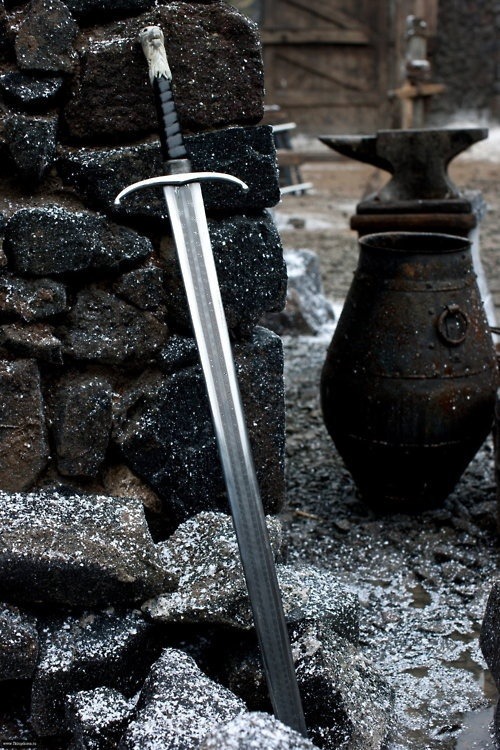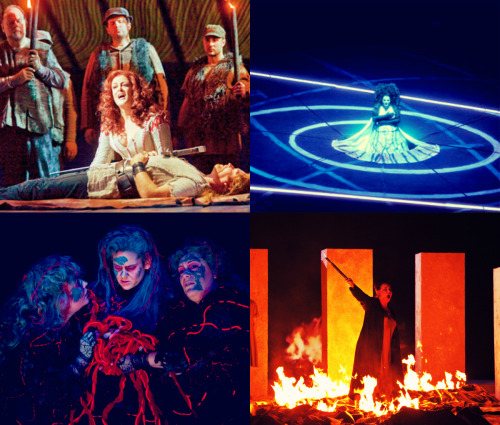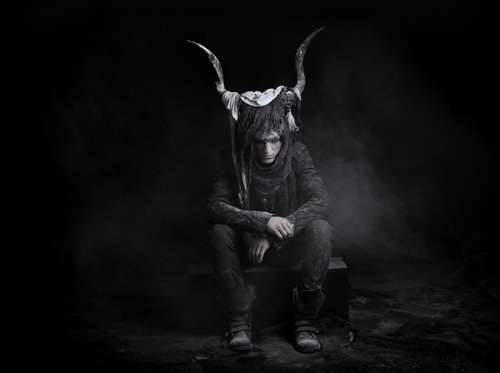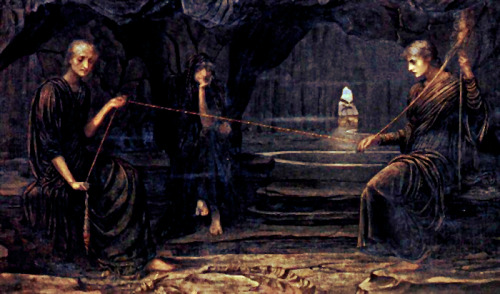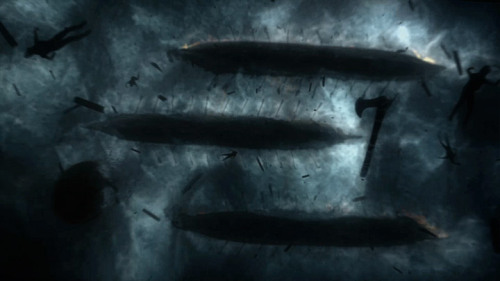#nott family
Blood-binding was common a millenium ago. Until Terrence Nott, a pureblood renowned for his fighting prowess and sadism, forced a hostage and enslaved goblin to forge him a sword for his flamboyant duels in court. Hatred and cruelty poured into the sword from the goblin’s magic, his anger at being kept like livestock holding tight to the blade. Once it was cooled not in water, but hot blood, it refused to bend to the wizard’s will.
No but it had a taste for his blood instead. Every duel, every battle, the blade would twist to harm its own, drawing slight cuts and scars. Terrence didn’t notice the wounds until it was too late. Until after the blade had had its fill and was left sated in cold fingers.
And that, that is why, young wix, we do not harden our swords in our own blood. Because sometimes it draws no loyalty. Only hunger.
(submitted by kittenboudicca)
Post link
They should have known with a middle name like Morta, that nothing good would come from her. Or at least, they ought not to have crossed her, ought not to have sold her off to Magnus Rowle for galleons to fill their coffers and pay of her brothers’ gambling debts. Not to a foulmouthed ruffian. Not even for a claim to the Orkneys.
But Lavinia Morta Nott rose far above them all, far above the schemes of her father, Isambardus Nott.
It begins with an innocent question that plays upon her father’s ambition. All the other families have great works of arts to their name - why have we none? And so she begins to name them. She whispers them in a feverish prayer wherever she goes. Arthur, Teutates, Haephestus, Bouddica, Hecate, Thor, Hengist, Robert the Bruce .Arthur, Teutates, Haephestus, Bouddica, Hecate, Thor, Hengist, Robert the Bruce. Again and again, never ceasing, inked in all her letters to her father, peppered in every conversation they have, thrown across dinner tables until all are singularly wearied of hearing those names.
What follows is a proud man’s folly. The other families have their tales and their tapestries. Isambardus Nott commissions an opera, Guðrún, he calls it and winks at his sour-faced brother Andros. Who’s to say we aren’t sons of Guðrúnor that our tale is fanciful? Children of Morgana and Arthur, indeed.
Lavinia ducks her head and hides her smile. All is going according to plan.
I will sing, she tells her Papa. I am a daughter of the Noble and Most Ancient House of Nott.Would you have a stranger sing our words and learn our magic? Let me sing, papa, I will make us proud - I will lift us far above the rest of them, I will show them what mettle the Noble and Most Ancient House of Nott is made of.
Andros says but one word and leaves his brother to his folly.
Hubris.
Guðrún premieres in Apollyon Hall in London on the 3rd of March, 1871. Lavinia Morta Nott is in full form. It is indeed an operatic spectacle and Lavinia wins the audience to her side with her first aria, swearing revenge against her brother Gunnar for murdering her true husband Sigurd. She flees into the forests and there she weaves her first magic; a tapestry that depicts a great war in which her brothers will be killed.
Again she is betrayed, this time by her mother, Grimhild who summons her brothers to her halls and bids them sneak a potion into Guðrún’s drink; a potion to forget the death of Sigurd. Alas, it is too late for the wheels of war are already in motion and the armies of the Hun come sweeping down from the hills into their plains. Guðrún forces herself to marry the Hun in order to save her family from their impending doom. In a touching aria, she considers the Hun and calls him a boor, a fool, a drunken philanderer, but this is her duty and she must do her duty by her family, even if it means a life time of unhappiness.
A third betrayal follows, this time at the hands of the Hun, who murders her brothers in a fulfillment of the prophecy she has woven into her tapestry, but has long forgotten under the spells her brothers have put on her. Unknowing, therefore, that it is she who had set this into motion, Guðrún prepares a last magic on stage - a magic which will end her husband and his family and win her her freedom. This time as she weaves and sings, it is not her mother who visists her but the three Norns, who beg her to reconsider her actions and stop this cycle of violence before it is too late. Guðrún refuses in a duet sung with the three Norns that is lauded for its stunning harmonic intricacies by the Arts section of The Daily Prophet the next day.
Her final revenge takes place during a large feast to celebrate one of the Hun’s many conquests. The Hun is halfway through his dinner when he finds that he has not been eating the flesh of the boar as he supposed, but the flesh of men, when the cook brings in the final course - the heads of his sons baked and basted.
Guðrún then sings her last aria, declaiming the Hun’s cruelties and falsehoods and then swears that she will have her revenge on him, even if it should take her life. The hall bursts into fire and Guðrún raises a torch triumphantly as it collapses all around her in flames, killing all the revellers, the Hun and herself.
The next day the front pages of The Daily Prophet are dedicated not to Lavinia Morta Nott’s stunning performance, but the massive fire at the Rowle family seat that killed Magnus Rowle, his family, his wife Lavinia Nott and all her family save her uncle - Andros Laocoön Nott.
Post link
The Sacred Twenty Eight: The Noble and Most Ancient Houses of Nott and Rowle
Ergi, the Rowles called them
And sneered,
But the Notts only smiled
And wove on in silence.
They might be ergi,
but they were seiðmenn
And they would never be blót.
The common wizards and witches of Britain had their own version of a very muggle saying - out of the frying pan and into the fire. Theirs was a little… different. For it went like this:
Fleeing the Blacks
only to cross the Notts.
The Blacks were dangerous, but nine times out of ten you knew precisely where you stood with them - they wore their hearts on their sleeves. If you insulted them, you could rest assured they would curse you, probably using some obscure dark curse no one had heard of and things would be well. Mostly.
But if you crossed a Nott, you’d never know it. They merely smiled and continued as though nothing were wrong at all. Excessively well-bred, always courteous - haute ton. But once you had left, they would return home, still smiling, and take down an ancient distaff and spindle; magical objects passed down from generation to generation for each Nott versed in the magical art of Seiðr.
Magical Britain laughed at divination and called it a fuzzy art with no magical grounding, for charlatans and their ilk, and the Notts agreed with them. Crystal balls, tea leaves, reading sticks - amateurs. The future was what people made it, what a talented seiðmenn orseiðkonurcould make it. The future was whatever the Notts chose to weave on their tapestries. Each thread, carefully placed, turning thought into reality, fiction into non-fiction, lies into truth.
None knew this better than the Rowles. They had learnt firsthand, many centuries ago, that mocking the Notts - these students of Odin - came with a price. A blood price that might have been honor to those who paid it but was a blood price nonetheless.
The Rowles might have been warrior-shamans; berserkers invulnerable in battle; but the might of the sword or even crude magical power could not withstand the implacable weaving and reweaving of reality and fate that the Notts took part in. Theirs was deeper magic, darker magic, terrifying magic and when the Rowles and Notts came to England with the first of the Vikings to rule Scotland, they brought rumours of what the Notts could do to people when crossed and people fearedthem.Fearedthese mild mannered men and women who refused to let this new religion called Christianity and its sociopolitical order sway them; who failed to conform to the new order’s strict regimentation of gender and male and female occupations; who smiled when people spurned them and smiled even wider when their mockers were slowly ruined piece by piece.
So not a murmur was heard when Proserpina Nott, aged 16, took up the family seat in the Wizengamot in 1734 though she was the youngest of the Notts and had not yet finished her schooling. The Ministry kept mum when Tiresias Nott refused to use their curriculum when teaching divination and instead taught his pupils trance magic and weaving: the beginnings of Seiðr. Wizengamot members cast their eyes downwards when Isembardus Nott stood up to make speeches, lest he see the judgement in their eyes when he painted his face and persisted in wearing pompadour wigs in public (it was 1854). People turned the the other way when Cantankerus Nott, pureblood fanatic extraordinaire, put half his fortune into muggle stocks and bonds. And no one dared say a word when Charles Nott stood a little too close to Antinous Lestrange at Ministry press conferences.
No. Only the foolish with a death wish ever crossed the path of a Nott. For they would have their revenge, these children of Guðrún, protégés of Odin and their revenge would be cold, dark and terror-filled as the houses of Hel.
[Picture sources: Shadows on Parade by Nicol Vizioli, CALLE 20 by Jose Herrera, The Essence by Spencer Hansen, Norns Bruk, A Golden Thread by John Melhuish Strudwick, screencaps from Vikings and 1066: the Battle for Middle Earth]
Post link

